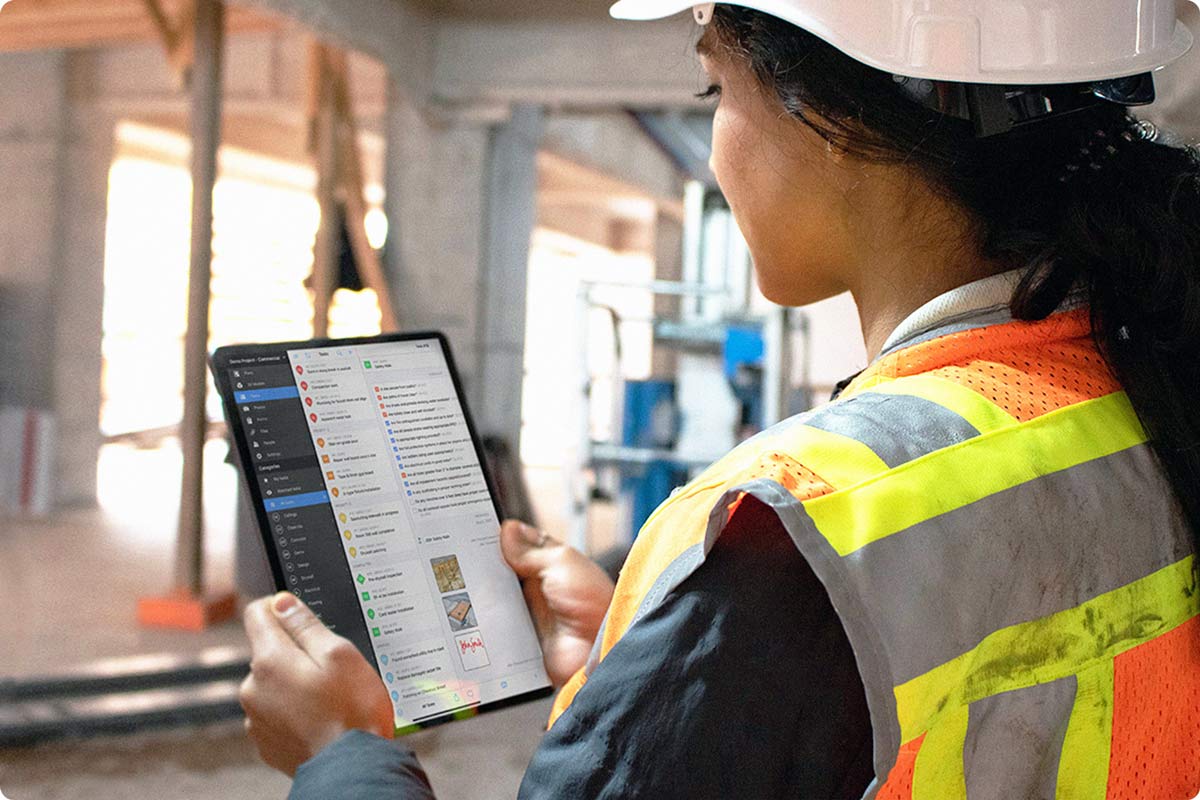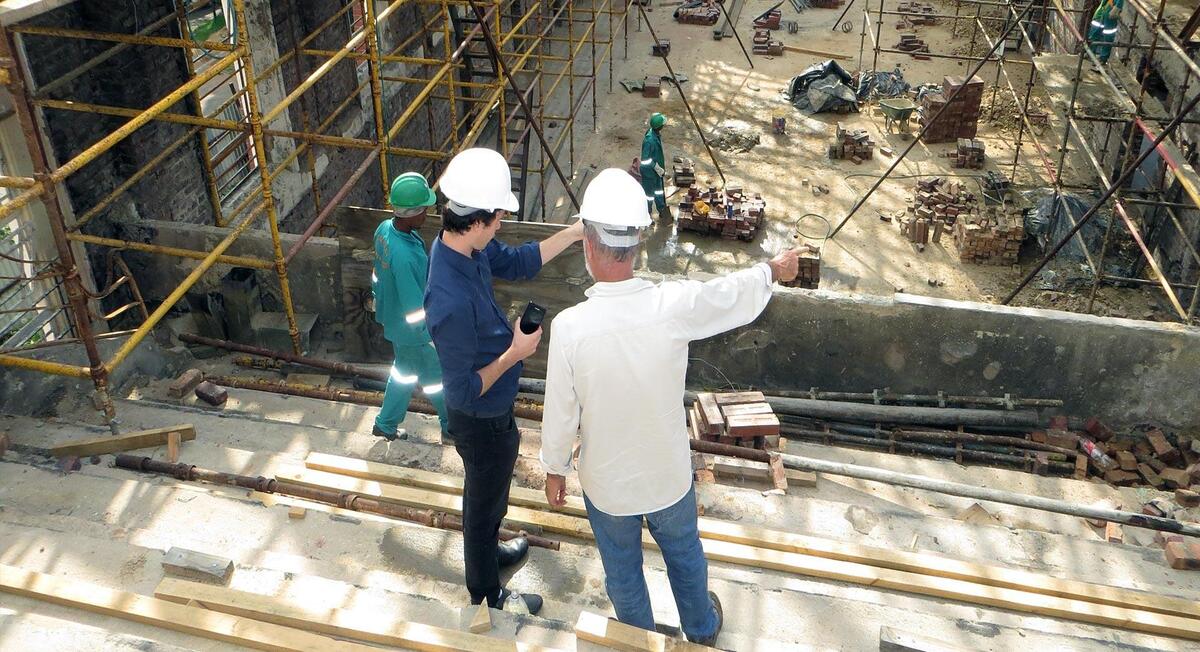Home>diy>Building & Construction>What Software Is Used In Construction Management


Building & Construction
What Software Is Used In Construction Management
Modified: January 9, 2024
Discover the top construction management software for building-construction projects. Streamline your processes and increase efficiency with these powerful tools.
(Many of the links in this article redirect to a specific reviewed product. Your purchase of these products through affiliate links helps to generate commission for Storables.com, at no extra cost. Learn more)
Introduction
In the dynamic field of construction, effective project management is crucial for success. With numerous tasks, stakeholders, and resources to coordinate, construction professionals rely on various software tools to streamline processes, enhance collaboration, and improve overall efficiency.
From project planning to design, estimation to scheduling, and document management to communication, construction management software plays a vital role in every stage of the construction project lifecycle.
This article explores the different types of software used in construction management, highlighting their features and benefits. By understanding these software tools, construction professionals can leverage technology to optimize their workflow, increase productivity, and deliver high-quality projects on time and within budget.
Let’s delve into the various software applications commonly used in construction management.
Key Takeaways:
- Construction management relies on a diverse range of software tools, from project management to BIM, to streamline processes, enhance collaboration, and ensure timely project delivery, revolutionizing the industry.
- By leveraging technology, construction professionals can optimize workflows, make informed decisions, and exceed client expectations, staying competitive in a fast-paced and evolving construction landscape.
Project Management Software
Project management software is the backbone of construction management. It provides a centralized platform for organizing and managing construction projects, ensuring smooth communication, efficient collaboration, and transparent tracking of tasks and progress.
Features of project management software include:
- Task management: Assigning and tracking tasks, setting priorities, and monitoring progress.
- Resource management: Managing labor, equipment, and materials, and optimizing their allocation.
- Budgeting and cost control: Tracking project expenses, monitoring budgets, and generating financial reports.
- Document management: Storing and retrieving project documents, contracts, permits, and other important files.
- Time tracking: Recording hours worked, managing timesheets, and monitoring project timelines.
- Collaboration tools: Facilitating communication and collaboration among project stakeholders, both internal and external.
Popular project management software in the construction industry includes:
- Procore: A cloud-based platform that offers project management, document control, bidding, and financial management features. Procore integrates with other software applications commonly used in construction, allowing seamless data flow and collaboration.
- BuilderTREND: Another widely used project management tool that offers features such as project scheduling, document management, customer management, and financials. BuilderTREND allows construction professionals to manage their projects from any device, providing real-time updates and insights.
- CMiC: A comprehensive construction management software that offers features for estimating, project controls, document management, financials, and more. CMiC aims to streamline workflows, improve efficiency, and drive profitability.
By utilizing project management software, construction professionals can effectively streamline their operations, minimize errors, and deliver projects on time and within budget. The ability to track progress, allocate resources, and communicate effectively is vital to successful construction project management.
Design and Modeling Software
In the construction industry, design and modeling software plays a pivotal role in bringing concepts to life and visualizing the final outcome of a project. These software tools enable architects, engineers, and designers to create detailed and accurate representations of buildings and structures.
Design and modeling software offer a range of features and capabilities, including:
- 2D and 3D modeling: Creating precise and realistic representations of building designs and structures.
- Building Information Modeling (BIM): A process that involves creating and managing digital representations of physical and functional characteristics of a facility. BIM software allows for collaboration, coordination, and simulation of design, construction, and operation.
- Integration with other software applications: Design and modeling software often integrate with other tools used in construction management, such as project management software and cost estimation software.
- Visualization and rendering: Generating high-quality images and visualizations to help stakeholders, clients, and construction teams better understand design intent.
- Analysis and simulation: Performing structural analysis, energy analysis, and other simulations to assess the performance and efficiency of a design.
Some popular design and modeling software used in the construction industry include:
- AutoCAD: A widely recognized computer-aided design (CAD) software that enables architects, engineers, and designers to create precise 2D and 3D drawings. AutoCAD offers various tools and features for drafting, modeling, and documentation.
- Revit: A BIM software that allows architects, engineers, and construction professionals to design, collaborate, and simulate construction projects. Revit offers a comprehensive set of tools for modeling, coordination, and documentation.
- SketchUp: A user-friendly 3D modeling software that is popular among architects and designers. SketchUp offers a simple and intuitive interface, making it easy to create 3D models and visualizations. It also integrates with other software tools, allowing for seamless collaboration.
Design and modeling software are essential in the construction industry as they enable project stakeholders to visualize and analyze design concepts, assess feasibility, and make informed decisions. These tools significantly contribute to the successful execution of construction projects by ensuring accurate planning, efficient coordination, and effective communication among teams.
Estimating and Costing Software
Estimating and costing software is a crucial component of construction management. It allows professionals to accurately estimate project costs, track expenses, and monitor budget throughout the life cycle of a construction project. This software is designed to facilitate efficient cost estimation, helping construction teams make informed decisions and ensure profitability.
Key features of estimating and costing software include:
- Quantity takeoff: Calculating material quantities required for a project based on project drawings and specifications.
- Cost database: Maintaining a database of material costs, labor rates, subcontractor fees, and other cost elements, allowing for accurate cost estimation.
- Cost breakdown: Breaking down project costs into different categories, such as labor, materials, equipment, permits, and overheads.
- Cost tracking: Monitoring project expenses in real-time and comparing them against the estimated budget.
- Change order management: Managing and tracking changes in project scope and associated costs.
- Integration with project management and accounting software: Ensuring seamless integration with other software tools to maintain data consistency and streamline processes.
Estimating and costing software significantly streamline the bidding and estimation process, allowing construction professionals to generate accurate and competitive bids. Additionally, it helps in project cost control and enables better financial planning.
Popular estimating and costing software used in the construction industry include:
- ProEst: A cloud-based estimating software that offers features for takeoff, cost estimating, bid management, and reporting. ProEst allows construction professionals to create detailed estimates quickly and accurately.
- ClearEstimates: This software provides construction estimating and bidding tools for residential and commercial projects. ClearEstimates offers pre-built templates, a cost database, and customizable reports.
- STACK: A cloud-based takeoff and estimating software that allows users to measure and price digital plans. STACK offers features for collaborative estimating, bid management, and reporting.
Estimating and costing software empowers construction professionals to make informed decisions, ensure accurate cost estimates, and maintain control over project finances. By leveraging these software tools, construction companies can improve their profitability and deliver projects within budget.
Scheduling Software
In the construction industry, effective project scheduling is essential for timely project delivery. Scheduling software allows construction professionals to create, manage, and track project schedules, ensuring that all activities are coordinated and executed in a timely manner.
Key features of scheduling software include:
- Task and activity planning: Creating a detailed schedule with tasks, dependencies, and durations.
- Resource allocation: Assigning resources, such as labor, equipment, and materials, to tasks and activities.
- Visual Gantt charts: Displaying project timelines and activities in a graphical format for easy visualization and understanding.
- Collaboration and communication tools: Facilitating communication and collaboration among project team members to coordinate tasks and resolve conflicts.
- Real-time monitoring: Tracking progress, identifying delays, and making adjustments to the schedule as needed to keep the project on track.
- Integration with other software applications: Scheduling software often integrates with project management software and accounting systems to ensure data consistency and streamline project management processes.
Scheduling software helps construction professionals optimize resource allocation, identify potential bottlenecks, and mitigate scheduling conflicts. It enables teams to visualize the project timeline, understand critical path activities, and make informed decisions to keep the project on schedule.
Some popular scheduling software used in the construction industry include:
- Microsoft Project: A comprehensive project management tool that offers powerful scheduling features, including Gantt charts, resource allocation, and critical path analysis. Microsoft Project allows construction professionals to plan and manage projects of all sizes and complexities.
- Primavera P6: A robust project management software widely used in the construction industry. Primavera P6 offers advanced scheduling capabilities, including resource leveling, schedule optimization, and earned value management.
- Procore: While primarily known as project management software, Procore also offers scheduling tools to help construction teams create and manage project schedules. With real-time updates and collaboration features, Procore ensures seamless scheduling and coordination.
Scheduling software is a vital tool for construction professionals to effectively manage project timelines, optimize resource utilization, and ensure timely project completion. By utilizing scheduling software, construction teams can enhance productivity, minimize delays, and improve overall project efficiency.
Read more: What Is Construction Management
Document and File Management Software
In the construction industry, managing documents and files is a critical function that requires efficient organization, storage, retrieval, and collaboration. Document and file management software provides construction professionals with a centralized platform to manage and control project-related documentation.
Key features of document and file management software include:
- Document storage and organization: Providing a secure and organized location to store project documents, drawings, contracts, and other related files.
- Version control: Managing different versions of documents and ensuring that the most up-to-date versions are accessible.
- Access control and permissions: Granting appropriate access rights to project team members, clients, and stakeholders to control who can view, edit, and download specific documents.
- Document search and retrieval: Offering robust search capabilities to quickly locate specific documents based on file names, tags, or content.
- Collaboration and workflow management: Allowing multiple users to work on documents simultaneously, track changes, and streamline approval processes.
- Integration with other software applications: Document management software often integrates with project management software, email clients, and other tools used in construction management to ensure seamless document flow and communication.
Document and file management software provides construction professionals with an organized and secure platform to manage project documentation, ensuring easy access to critical information and reducing the risk of lost or outdated documents.
Some popular document and file management software used in the construction industry include:
- Procore: Along with its project management features, Procore offers robust document management capabilities, allowing construction teams to store, organize, and control project documents with ease. It provides features like annotation tools, file syncing, and customizable document workflows.
- PlanGrid: PlanGrid is a cloud-based construction document management platform that specializes in drawings and blueprints. It allows teams to upload, view, mark-up, and distribute project documents in real-time, streamlining the document review and approval process.
- Bluebeam Revu: Bluebeam Revu is a PDF-based collaboration software that allows construction professionals to create, edit, and manage project documents. It offers features like document markup, cloud storage integration, and real-time collaboration.
Document and file management software helps construction professionals improve document accessibility, collaboration, and control. It ensures that project teams have the latest information at their fingertips, leading to enhanced efficiency, reduced errors, and improved project outcomes.
One popular software used in construction management is Procore, which helps with project management, quality control, and communication among team members.
Collaborative and Communication Software
In the fast-paced world of construction, effective collaboration and communication among project teams, clients, and stakeholders are crucial for project success. Collaborative and communication software enables seamless information sharing, real-time collaboration, and efficient communication channels for construction professionals.
Key features of collaborative and communication software include:
- File sharing: Allowing users to share project-related documents, drawings, and files with team members, clients, and stakeholders securely.
- Real-time messaging: Providing instant messaging capabilities for quick and direct communication between team members, regardless of their location.
- Video conferencing: Enabling virtual face-to-face meetings and discussions through video conferencing tools for remote team members or clients.
- Task management and assignment: Assigning, tracking, and managing tasks within the software, ensuring accountability and transparency among team members.
- Commenting and discussion threads: Facilitating discussions and comments on specific documents, tasks, or project updates, keeping all communication organized and accessible.
- Integration with other software applications: Collaborative and communication software often integrates with project management software, document management tools, and other construction management applications to ensure seamless data flow and streamline processes.
By utilizing collaborative and communication software, construction professionals can break down communication barriers, enhance team collaboration, and ensure that all stakeholders are aligned and informed throughout the project lifecycle.
Some popular collaborative and communication software used in the construction industry include:
- Slack: A popular real-time messaging platform that allows teams to communicate through channels, direct messages, and file sharing. Slack provides integration with various tools and offers a user-friendly interface for efficient team collaboration.
- Microsoft Teams: Microsoft Teams is a comprehensive collaboration platform that combines chat, video meetings, file sharing, and task management in one place. It is widely used for effective communication and collaboration in construction projects.
- Basecamp: Basecamp offers an all-in-one project management and communication platform that allows teams to create to-do lists, share documents, and have discussions. It provides a centralized hub for project communication and collaboration.
Collaborative and communication software empowers construction teams to collaborate effectively, share information efficiently, and foster a culture of open communication. By leveraging these tools, construction professionals can improve project coordination, accelerate decision-making, and drive successful project outcomes.
BIM Software
Building Information Modeling (BIM) software has revolutionized the construction industry by enabling comprehensive digital representation and management of building projects. BIM software allows construction professionals to create, collaborate on, and visualize intelligent 3D models that contain detailed information about the physical and functional aspects of a building.
Key features of BIM software include:
- 3D modeling: Creating realistic and detailed 3D models of buildings, including architectural, structural, and MEP (Mechanical, Electrical, and Plumbing) systems.
- Data integration: Collating various data sources and integrating them into the BIM model, including specifications, schedules, material quantities, and cost estimates.
- Coordination and clash detection: Identifying clashes and conflicts between different building elements in the virtual model, enabling efficient coordination and reducing rework during construction.
- Visualization and simulation: Offering visual representations of the building model, allowing stakeholders to explore designs, analyze performance, and simulate construction processes.
- Collaboration and information sharing: Facilitating collaboration among multidisciplinary teams by providing a common platform for sharing models, data, and project information.
- Asset and facility management: Leveraging the BIM model for ongoing facility management, maintenance planning, and renovations throughout the building lifecycle.
BIM software significantly enhances project coordination, reduces errors and conflicts, and improves overall productivity in the construction process.
Popular BIM software used in the construction industry includes:
- Autodesk Revit: One of the most widely used BIM software applications that allows construction professionals to create intelligent 3D models, perform simulations, and manage project data. Revit integrates with other Autodesk products and facilitates collaboration through cloud-based sharing.
- Graphisoft ARCHICAD: ARCHICAD offers 3D modeling, coordination, and collaboration features. It provides an intuitive interface and allows seamless integration with other software applications, enhancing workflow efficiency and accuracy.
- Bentley AECOsim: A comprehensive BIM software that supports multidisciplinary collaboration on a single integrated platform. AECOsim incorporates advanced design and analysis tools, facilitating accurate and coordinated building design.
BIM software has transformed the construction industry by enabling improved project visualization, coordination, and information management. Construction professionals who embrace BIM technology can benefit from increased efficiency, reduced costs, and enhanced project outcomes.
Quality and Safety Management Software
In the construction industry, ensuring quality and safety is of paramount importance to protect workers, meet regulatory requirements, and deliver projects that meet or exceed client expectations. Quality and safety management software enables construction professionals to effectively manage and monitor quality control measures and safety protocols throughout the project lifecycle.
Key features of quality and safety management software include:
- Inspection and audit management: Conducting structured inspections and audits to assess compliance with quality and safety standards.
- Non-conformance tracking: Identifying and tracking instances of non-compliance or quality issues and facilitating corrective actions.
- Incident and accident reporting: Documenting and investigating incidents, accidents, near-misses, and safety hazards to ensure a safe working environment.
- Training and certification management: Managing training requirements for workers, tracking certifications, and ensuring compliance with safety regulations.
- Document control: Centralizing quality and safety-related documents, such as safety manuals, inspection reports, and standard operating procedures.
- Real-time reporting and analytics: Generating reports and analytics to assess performance, identify trends, and make data-driven decisions for continuous improvement.
Quality and safety management software helps construction professionals proactively manage risks, identify areas for improvement, and maintain compliance with industry regulations and standards.
Popular quality and safety management software used in the construction industry include:
- iAuditor: A mobile inspection app that allows construction professionals to conduct inspections, generate inspection reports, and track corrective actions. iAuditor provides a user-friendly interface and offers powerful data analytics capabilities.
- PmWeb: PmWeb is a comprehensive project management software that includes quality and safety management features. It enables construction professionals to manage inspections, track issues, and ensure compliance with quality and safety standards.
- SafetyCulture: SafetyCulture offers a suite of software tools for safety and quality management. Its iAuditor app, along with other modules such as incident reporting and hazard management, helps construction teams maintain a safe work environment and ensure quality outcomes.
By implementing quality and safety management software, construction professionals can mitigate risks, enhance safety performance, and deliver projects of the highest quality while adhering to industry safety standards.
Read more: What Is Construction Manager At Risk
Equipment and Asset Management Software
In the construction industry, effective management of equipment and assets is crucial for ensuring project efficiency and maximizing return on investment. Equipment and asset management software provides construction professionals with the tools to streamline the tracking, maintenance, and utilization of equipment and assets throughout the project lifecycle.
Key features of equipment and asset management software include:
- Asset tracking: Digitally tracking equipment and assets, including location, status, utilization, and maintenance history.
- Maintenance scheduling: Scheduling and managing preventative maintenance tasks to ensure optimal performance and longevity of equipment and assets.
- Inventory management: Tracking inventory levels of consumables and spare parts, ensuring adequate stock availability for smooth project operations.
- Equipment utilization: Analyzing equipment usage and efficiency to make informed decisions about equipment deployment and allocation.
- Rental and maintenance tracking: Managing rental agreements, tracking rental costs, and scheduling equipment maintenance for rented equipment.
- Integration with financial systems: Integrating with accounting software to accurately track equipment costs, depreciation, and overall project expenses.
Equipment and asset management software enables construction professionals to optimize equipment usage, reduce downtime, and ensure that projects run smoothly without delays caused by equipment issues.
Popular equipment and asset management software used in the construction industry include:
- Fiix: Fiix is a comprehensive maintenance management software that includes features for equipment and asset management. It offers functionalities for work order management, inventory control, and maintenance scheduling, allowing construction teams to effectively manage their equipment and assets.
- ToolWatch: ToolWatch is a specialized software tailored for construction equipment and tool management. It helps construction professionals track and manage inventory, schedule equipment maintenance, and improve resource utilization.
- Hippo CMMS: Hippo CMMS is a cloud-based maintenance management system that supports equipment and asset management. It provides features for maintenance planning, resource allocation, and equipment history tracking.
By utilizing equipment and asset management software, construction professionals can optimize equipment usage, track maintenance activities, and ensure that projects are executed smoothly and efficiently, minimizing downtime and maximizing productivity.
Reporting and Analytics Software
In the construction industry, the ability to generate accurate reports and analyze project data is crucial for informed decision-making, performance evaluation, and continuous improvement. Reporting and analytics software enables construction professionals to extract valuable insights from project data, monitor performance metrics, and generate comprehensive reports for stakeholders.
Key features of reporting and analytics software include:
- Data visualization: Presenting project data in visual formats such as charts, graphs, and dashboards to easily understand trends, patterns, and key performance indicators (KPIs).
- Customizable reports: Building customized reports to suit specific project requirements and stakeholder needs.
- Real-time data tracking: Collecting and analyzing real-time data from various sources, including project management software, financial systems, and other construction management tools.
- Performance monitoring: Tracking and monitoring project performance metrics, such as schedule adherence, budget variances, resource utilization, and safety incidents.
- Forecasting and predictive analytics: Using historical data and statistical models to predict future project outcomes and make informed decisions.
- Integration with other tools: Integrating with project management software, financial systems, and other construction management applications to collect data seamlessly.
Reporting and analytics software allows construction professionals to gain actionable insights and make data-driven decisions for improved efficiency, cost control, and project success.
Popular reporting and analytics software used in the construction industry include:
- Tableau: Tableau is a powerful data visualization and analytics tool that allows construction professionals to create interactive dashboards, reports, and visualizations based on project data. It provides advanced analytics capabilities for detailed data analysis.
- Power BI: Power BI is a business intelligence tool that enables construction professionals to create rich, interactive reports and dashboards. It integrates with various data sources and offers robust analytics capabilities.
- Klipfolio: Klipfolio is a cloud-based analytics platform that allows construction professionals to build custom dashboards and reports to track, visualize, and analyze project data in real-time.
By leveraging reporting and analytics software, construction professionals can gain valuable insights into project performance, make informed decisions, and improve overall project outcomes by constantly identifying areas for optimization and enhancement.
Conclusion
In the construction industry, the use of software tools has become essential to streamline processes, enhance collaboration, and improve project outcomes. From project management to design and modeling, estimating to scheduling, document management to quality control, construction professionals rely on a wide range of software applications to effectively manage every aspect of construction projects.
We have explored various types of software used in construction management, including project management software, design and modeling software, estimating and costing software, scheduling software, document and file management software, collaborative and communication software, BIM software, quality and safety management software, equipment and asset management software, and reporting and analytics software.
These software tools empower construction professionals to optimize project workflows, make informed decisions, improve efficiency, and ensure timely project delivery. By leveraging technology, construction companies can enhance collaboration among project stakeholders, streamline processes, reduce errors and rework, and ultimately enhance project success.
As the construction industry continues to evolve, it is crucial for professionals to adapt and embrace the potential of software solutions. Integrating these software tools into everyday construction management practices can help companies stay competitive, deliver high-quality projects within budget and on schedule, and exceed client expectations.
It is important to choose the right software tools based on project requirements, team needs, and scalability. Construction professionals should consider factors such as ease of use, integration capabilities, support and training options, and overall value for investment when selecting software solutions.
In conclusion, the utilization of software tools in construction management has revolutionized the industry, enabling more efficient processes, improved communication, better collaboration, and enhanced project outcomes. Embracing these technologies is key to staying ahead in a fast-paced and competitive construction landscape.
Frequently Asked Questions about What Software Is Used In Construction Management
Was this page helpful?
At Storables.com, we guarantee accurate and reliable information. Our content, validated by Expert Board Contributors, is crafted following stringent Editorial Policies. We're committed to providing you with well-researched, expert-backed insights for all your informational needs.














0 thoughts on “What Software Is Used In Construction Management”